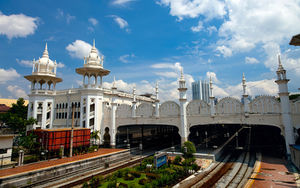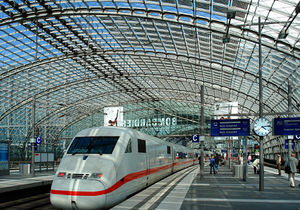St Patras Station: Difference between revisions
(Created page with "thumb|The exterior of Patras Station seen from the view of trains entering the station. The St Patras Station was built in 1981 utilizing classical Islam...") |
|||
| (2 intermediate revisions by 2 users not shown) | |||
| Line 1: | Line 1: | ||
[[File:Patras1.jpg|thumb|The exterior of Patras Station seen from the view of trains entering the station.]] | [[File:Patras1.jpg|thumb|The exterior of Patras Station seen from the view of trains entering the station.]] | ||
The St Patras Station was built in 1981 utilizing classical Islamic architecture from [[Sayaffallah]]. The station sees 2.5 million passengers per year and is a hub for [[wikipedia:TGV|High Speed Trains]]. | The '''St Patras Station''' was built in the city of [[Patras]] on the colonized planet of [[Baras]] in 1981 utilizing classical Islamic architecture from [[Sayaffallah]]. The station sees 2.5 million passengers per year and is a hub for [[wikipedia:TGV|High Speed Trains]]. | ||
== Direct connections == | |||
Direct routes to [[Jaringaster]] and [[Talase]] are regular features of the St Patras Station and the most popular routes bought by customers on a daily basis. | Direct routes to [[Jaringaster]] and [[Talase]] are regular features of the St Patras Station and the most popular routes bought by customers on a daily basis. | ||
==History== | ==History== | ||
===Construction=== | ===Construction=== | ||
| Line 23: | Line 19: | ||
[[Category: Sayaffallah]] | [[Category: Sayaffallah]] | ||
[[Category: Railway stations]] | |||
Latest revision as of 15:36, 10 August 2022
The St Patras Station was built in the city of Patras on the colonized planet of Baras in 1981 utilizing classical Islamic architecture from Sayaffallah. The station sees 2.5 million passengers per year and is a hub for High Speed Trains.
Direct connections
Direct routes to Jaringaster and Talase are regular features of the St Patras Station and the most popular routes bought by customers on a daily basis.
History
Construction
Construction began in January 1981 and utilized an initial steel and concrete reinforced frame with large glass paneling for the roof areas of the station. The interior features a large glass ceiling sloping off into the wall areas on either side of the station. On the exterior the distinctive minarets of Sayaffallan Islamic period architecture can be seen along with the domed towers that are iconic in much of the northern areas of Sayaffallah. Construction also expanded to include a shopping mall built into part of the train plaza allowing customers waiting for trains or just arriving to do shopping before they formally exit the station and enter the city proper itself.
Opening
The Station formally opened on December 2, 1981 and the first trains departed on the same day as daily service began.

